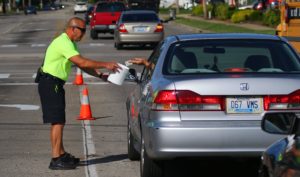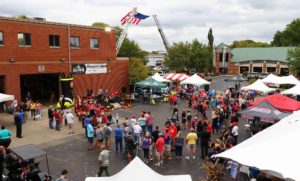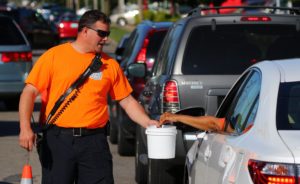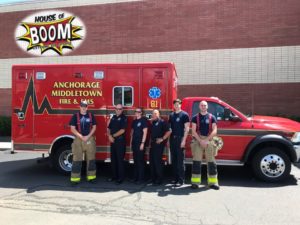Annual Fundraiser Has Deep Roots in the Local Community
Writer / Carrie Vittitoe
Photography Provided
 Theres a lot of history and tradition that goes along with the WHAS Crusade for Children, says Dawn Lee, president and CEO of the nonprofit organization.
Theres a lot of history and tradition that goes along with the WHAS Crusade for Children, says Dawn Lee, president and CEO of the nonprofit organization.
Even though Lee has been in her role for more than a decade, she says she still often feels like the new girl because so many Crusade staff members and volunteers have been there so much longer. When she first began, she asked local fire departments what the most important thing was that she could do to support them in their Crusade efforts.
They said, To stay out of the way, she says with a laugh.
Lee has tried to abide by those instructions, serving as a cheerleader for fire departments and trying to find new ways to appeal to a community that is very different from what it was in 1954, when the WHAS Crusade for Children officially began.
Crusade History
Even though the official start of the Crusade was in 1954, it truly began in 1952 when local parents of children with cerebral palsy decided to organize a United Cerebral Palsy Parade of Stars Telethon. At that time, television was the latest technology.
Barry Bingham, who was the owner of the Courier-Journal and WHAS radio and television stations, and Vic Sholis, the television stations general manager, supported the telethon, but Lee says they were disappointed that the money generated didnt stay in the community.
Part of the money went to cover overhead, part of the money went to a national office in New York, and the remainder then helped children here in our community, she says.
Bingham and Sholis decided to start the WHAS Crusade for Children in 1954 and give 100% of the money raised to local children with special needs.
Memorial Auditorium was the site of the 1954 Crusade, and people lined up around the block in order to walk onto the stage where they made donations. Celebrities like Randy Atcher, Tom Cactus Brooks and Pat OBrien participated.
These people were well-known in the community, Lee says.
The Crusade was a major televised event, in part because there were only three local television stations.
Operators from Southern Bell answered telephones in the basement beneath the stage, watching dust fall from the rafters when tap dancers performed above their heads. Many of these operators, even after their retirement, continued to volunteer for the Crusade in later years.
The 1954 Crusade raised $157,000, which was below the $200,000 telethon goal. Crusade leadership decided then that it would no longer have a stated goal for the telethon.
They said, This is a community charity – the community is going to do whatever they can. Theres no reason for them to feel disappointed, Lee says.
 The Role of Fire Departments in the Crusade
The Role of Fire Departments in the Crusade
In 1958, the chief of the Pleasure Ridge Park (PRP) fire department, Ernie Bohler, challenged other departments to beat PRPs donation the following year.
They all just took it and ran with it, Lee says. Even today, it has that friendly rivalry aspect.
Fire department donations are not limited to Crusade weekend, which is the first weekend of June each year. Fire departments host breakfast with Santa events, fishing tournaments, golf outings and 5K runs in order to make giving to the Crusade a year-round endeavor.
Fire departments collect over half of what we bring in every year, Lee says.
The mergers of fire departments in Louisville have not yet impacted the Crusade, but that is always a concern for the charity. Even when departments have combined, there is still a regional feel and connection for people in the community, and they support their closest fire departments. Jeffersontown and McMahan have cumulatively collected more than $4 million. St. Matthews and Lyndons cumulative total is more than $4 million. The merged Anchorage and Middletown departments, with Eastwood, Harrods Creek and Worthington in the mix, have collected more than $6 million.
In years past, firefighters from surrounding areas would bring their donations to Louisville so they could be on the telethon, but that meant tying up staff and equipment for hours and hours. Now, with remote locations, departments in communities including Bardstown, Elizabethtown, Ballardsville and Leitchfield, as well as Corydon, Indiana, can participate without an extensive time commitment.
Changes Through Time
In some ways, the WHAS Crusade is anachronistic – it is built on a model of telethons that doesnt exist anymore.
Were the longest-running, most successful local telethon, Lee says. Thats because no one is really doing telethons anymore.
Because television viewing habits have changed so drastically, WHAS Crusade for Children leaders have to think outside the box and make the Crusade more user-friendly to viewers who watch Netflix, Hulu, and Disney+. For the past two years, for example, the telethon has been live-streamed on social media.
Crusade leaders have also expanded how donations are accepted, since many people no longer carry cash. They have successfully accepted donations through Venmo and Alexa.
While the Crusades focus has always been on helping children, especially those with special needs, there has been a change in the kinds of special needs children have. While some children who benefit from the Crusade may have physical needs that require wheelchairs and other equipment as well as medical care, many children have emotional or cognitive needs that require different kinds of care.
What Has Stayed the Same
Since the Crusade was established, ministers from various denominations with a variety of backgrounds have made the decisions about where the money goes.
These ministers have no vested interest besides helping children in our community, Lee says.
Agencies, schools and hospitals submit grants to the Crusade each year.
The ministers review all those grants, and we will schedule hearings where each grant applicant comes in and defends their grant request, Lee says.
Each year there are 250 hearings, but there are more grant requests.
If an organization gets a WHAS Crusade for Children grant, they proceed with their project, and submit receipts, invoices and contracts to the Crusade for reimbursement.
We never have to wonder if they did what their grant said, Lee says. Were going to make sure of that before the money goes out.
While this process requires a lot of time and paperwork, it also means that people who donate can feel confident that their money is being well-utilized.
Into the Future
Even as the Crusade leaders strive to be flexible enough to adopt new technologies, they also continue to play to their strengths as a community charity that is all about giving.
While the Crusade staff is a lean outfit of seven individuals, it is hard to put a number on the amount of people who make the Crusade happen. More than 200 fire departments in Kentucky and southern Indiana volunteer and collect for the Crusade. On Crusade Sunday, more than 3,000 people drop by or work at the station.
The number of people who have been positively impacted by the WHAS Crusade for Children is even larger, including children with special needs, families that have received support, and the thousands of Louisville residents who know that screaming sirens and flashing lights on the first weekend of June are a cause for celebration, not worry or fear.
For more info, visit whascrusade.org.


 The Role of Fire Departments in the Crusade
The Role of Fire Departments in the Crusade

